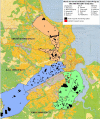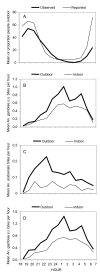Interdependence of domestic malaria prevention measures and mosquito-human interactions in urban Dar es Salaam, Tanzania
- PMID: 17880679
- PMCID: PMC2039744
- DOI: 10.1186/1475-2875-6-126
Interdependence of domestic malaria prevention measures and mosquito-human interactions in urban Dar es Salaam, Tanzania
Abstract
Background: Successful malaria vector control depends on understanding behavioural interactions between mosquitoes and humans, which are highly setting-specific and may have characteristic features in urban environments. Here mosquito biting patterns in Dar es Salaam, Tanzania are examined and the protection against exposure to malaria transmission that is afforded to residents by using an insecticide-treated net (ITN) is estimated.
Methods: Mosquito biting activity over the course of the night was estimated by human landing catch in 216 houses and 1,064 residents were interviewed to determine usage of protection measures and the proportion of each hour of the night spent sleeping indoors, awake indoors, and outdoors.
Results: Hourly variations in biting activity by members of the Anopheles gambiae complex were consistent with classical reports but the proportion of these vectors caught outdoors in Dar es Salaam was almost double that of rural Tanzania. Overall, ITNs confer less protection against exophagic vectors in Dar es Salaam than in rural southern Tanzania (59% versus 70%). More alarmingly, a biting activity maximum that precedes 10 pm and much lower levels of ITN protection against exposure (38%) were observed for Anopheles arabiensis, a vector of modest importance locally, but which predominates transmission in large parts of Africa.
Conclusion: In a situation of changing mosquito and human behaviour, ITNs may confer lower, but still useful, levels of personal protection which can be complemented by communal transmission suppression at high coverage. Mosquito-proofing houses appeared to be the intervention of choice amongst residents and further options for preventing outdoor transmission include larviciding and environmental management.
Figures








References
-
- WHO . Global Strategic Framework for Integrated Vector Management. Geneva , World Health Organization; 2004. p. 15.
-
- RollBackMalariaPartnership . World Malaria Report. Geneva , World Health Organization; 2005.
-
- Kiszewski A, Mellinger A, Spielman A, Malaney P, Sachs SE, Sachs J. A global index representing the stability of malaria transmission. Am J Trop Med Hyg. 2004;70:486–498. - PubMed
Publication types
MeSH terms
Grants and funding
LinkOut - more resources
Full Text Sources
Medical

